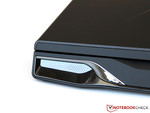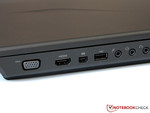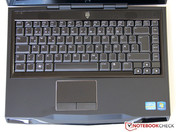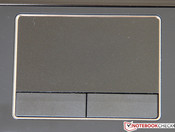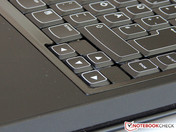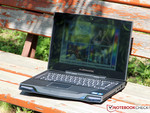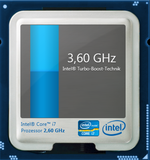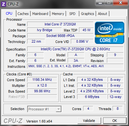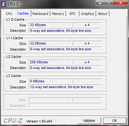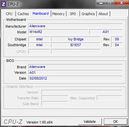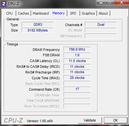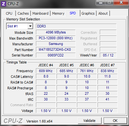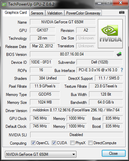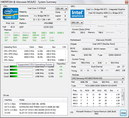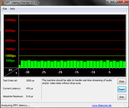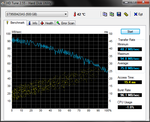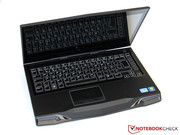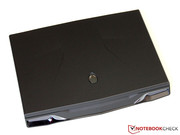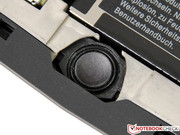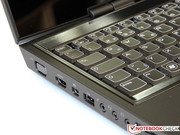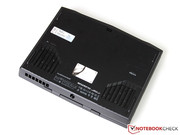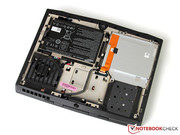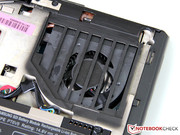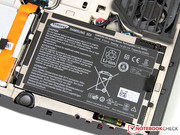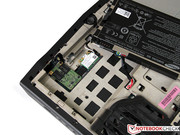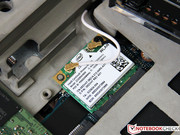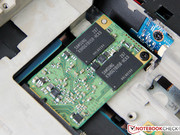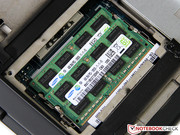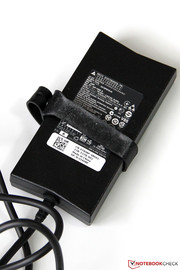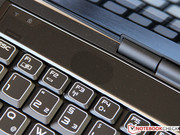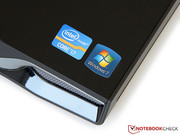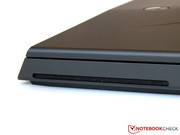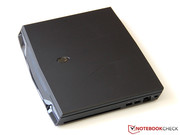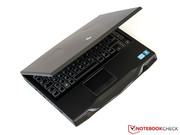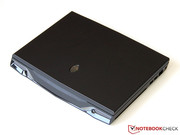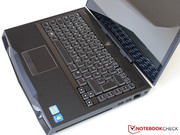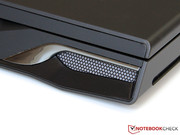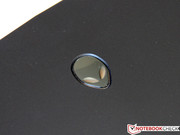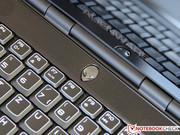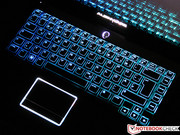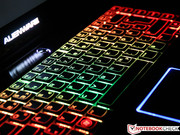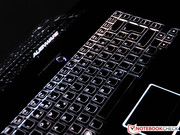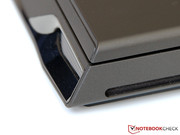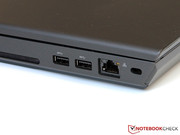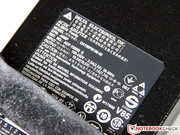Alienware M14x R2 Review

Formerly a mid-range offering, the M14x is now Alienware's entry model with regard to both size and price after the manufacturer discontinued the 11.6 inch M11x. Precisely one year ago we tested the previous version of the powerful 14 inch unit and were duly impressed. Aside from high noise levels under load, we could hardly find any deciding points of critique.
As a result, expectations for the second revision are accordingly high. In addition to the entry level configuration featuring a Core i5-2450M, the brand new Ivy Bridge quad-core processors i7-3720QM and i7-3820QM are also available. Together with a GeForce GT 650M and up to 16 GB of DDR3 RAM, they should offer a noticeable performance increase over the predecessor. For storage, the manufacturer offers various hard drives and SSDs, some of which are also available as hybrids or raid arrays.
Due to rather brazen upgrade pricing, the base price of 1,149 Euro ($1430 USD) skyrockets past 1,500 Euro ($1860 USD) rather quickly. For example, a mere 64 GB mSATA SSD carries a massive 139.99 Euro ($175 USD) price tag. Even our test model with a merely average configuration set us back 1,650 Euro ($2050 USD).
Since the majority of the gaming competition does not offer 14 inch models, we will make comparisons to both larger and smaller machines with otherwise comparable specifications. For this purpose, we will consider two Schenker notebooks, the XMG A102 and A502, which were also recently upgraded to Intel's latest Ivy Bridge platform. Another interesting alternative could be the Asus G55VW which was also recently reviewed.
Case
An extravagant design has always been the trademark of Alienware's notebooks. The M14x R2 is no exception here and will light up colorfully and brightly like an amusement park if one so desires. One can choose from 20 different colors in nine different zones, four of which make up the keyboard. Even constant color changes can be set. If one prefers things more subdued, it is possible to disable everything beyond the basic keyboard backlight.
These possibilities are already familiar to us from last year's test. Overall, the case shows no visible changes from its predecessor. This is hardly a criticism as the quality and workmanship of this 2.9 kg (6.4 pound) heavy and 3.8 centimeter (1.5 inch) thick notebook is hardly matched by anyone. Case stability is absolutely excellent and only gives minimally even to selective pressure. A better torsional stability of the display lid remains on our wish list, but that is criticism at a highly particular level. The precise and smooth display hinges are notable as well. Thanks to the heavy base unit, opening the lid with one hand is no problem.
The gummed surfaces and materials used for the exterior are above reproach as well and the M14x continues to retain its "very good" overall rating. Even though the Schenker notebooks XMG A102 and A502, which use the Clevo bare bones package, are in no way bad in this regard there is still a noticeable difference in quality. It should be noted that this difference in quality also comes with a noticeable difference in price.
Connectivity
As the case remains unchanged, the connectors similarly remain unchanged. The parallels to the 2011 model continue here. There are still three USB ports in total, two of which are the faster USB 3.0. As with other Ivy Bridge models, it is surprising that old USB 2.0 connectors are even installed at all as the HM77 chip set would allow all ports to use the faster and more modern USB 3.0 specification.
HDMI, Mini DisplayPort, and VGA are all available allowing one to connect virtually any external display. Last year, we criticized the lack of eSATA, Firewire, and ExpressCard slots. At this time, we would like to qualify those statements. Due to the diminishing distribution of these interfaces, increasingly fewer buyers will notice their absence.
In regards to all further interfaces and information about them, we want to reiterate our reference to our review of the first M14x.
Communications
In Alienware's online configurator, we had a choice of Intel's Centrino Wireless-N 2230 (as in our test model) or the Qualcomm / Bigfoot Killer Wireless-N 1202. Both adapters are MIMO capable (2x2) and allow overall data rates of up to 300 MBit/s. In addition, the latest version of Bluetooth (Bluetooth 4.0) is on board. Arguments to spend an extra 20 Euro ($25 USD) for the Qualcomm adapter consist of the support of 802.11a for 5 GHz networks, as well as firmware optimizations to provide online gamers with faster pings to reduce lag. An integrated 3G or 4G radio is not available for the M14x.
The notebook's webcam has the usual 1.3 Megapixel resolution and accordingly delivers middling picture quality. Sharpness and noise of this sensor could be better. On the other hand, video playback shines with high contrast, little delay, and perfectly fluid playback. The microphone array installed to the left and right of the webcam is of surprisingly high quality and its recordings sound very natural and maintain good dynamic range.
Accessories
Aside from a few pamphlets, Alienware also includes a Windows 7 Home Premium SP1 64-bit DVD, as well as two driver and software DVDs. We tip our hat to Dell as this is rare these days. We particularly liked the soft cloth cover which serves as perfect protection for transport in a backpack or similar container. Naturally a power supply with a maximum output of 150 Watts is included to supply the notebook's power hungry high-end components.
Various Alienware programs allow the user to set lighting, back up data, or modify power savings profiles. These programs match Alienware's dark, futuristic design. Luckily, customers are largely spared unnecessary collections of toolbars and other software that might bog down the operating system.
Service
Removing 2 screws and pushing the service hatch cover rearward is all that is required to access the M14x's interior. Inside, it looks a little different from other notebooks. Rather than the typical green circuit boards, the user initially encounters further covers and screws. Once these are removed, pretty much all important components can be reached and swapped if desired. One should not forget to take a look underneath the battery where the mSATA connector (already in use) and the WiFi radio dwell.
Warranty
Only a one-year on-site service warranty (next work day) is included. For a device in this price range, this is definitely not enough in our opinion. Warranty extensions beyond this will leave a deep crater in the wallet. A two-year warranty costs 195 Euro ($240 USD) and a three-year warranty costs an enormous 460 Euro ($570 USD). These costs appear exaggerated in comparison to other vendors. Even though software and telephone support is included, many customers will think twice before paying such high premiums.
Keyboard
If one is not fond of the chiclet trend used by most large manufacturers, the M14x offers relief with its classic desktop keyboard design. The standard layout will save one from having to familiarize oneself with the keyboard. Also notable is the thin white border around every key, as well as the already mentioned backlighting (see case).
Thanks to their concave surface and slanted sides, the 18mm (0.7 inch) keys are easy to hit unerringly. On some chiclet keyboards, only very skilled typists can manage as well as one might with this traditional design. The firm and precise pressure point in combination with an unusually generous depth of stroke provide excellent feedback, which could serve as an example to more than a few business notebooks. Unlike our last test, we did not find any squeaking keys, but this keyboard is also not the quietest example of its kind with its minimally rattling typing sound.
Touchpad
The Synaptics touch pad does its duty with perfect precision and excellent glide characteristics. There are no differences to its predecessor or other particularities to report so we leave the reader with another link to the relevant test.
Overall, the quality of the input devices is on a very high level and surpasses most competitors in the gaming sector. Other than an external mouse, something that is mandatory for gamers anyways, there seems to be no need for any further peripherals such as an external keyboard.
In our test of the Schenker XMG A102, there was just one serious negative: the disappointing display featured merely plain HD resolution (1366x768), weak contrast, and was reflective as well. Although the available displays for the M14x are also reflective, at least there is an option for a 1600x900 pixel HD+ screen for an extra 50 Euros ($62 USD) which we also chose for our test model over the standard WXGA display. The resulting pixel density of 131 dpi is similar to the XMG A102, but thanks to the larger screen size, one can work much more effectively on the M14x. Maybe Alienware could have offered an even larger 16:10 display, as the display bezel turned out rather wide at the top and bottom edges.
With an average brightness of 266 cd/m2, the display is exactly equal to the predecessor's display and should suffice for most purposes. Regrettably the illumination is disappointing, with a noticeable dark area at the bottom edge which could be just an issue of our particular unit.
| |||||||||||||||||||||||||
Brightness Distribution: 83 %
Center on Battery: 274 cd/m²
Contrast: 623:1 (Black: 0.44 cd/m²)
40.59% AdobeRGB 1998 (Argyll 3D)
57.1% sRGB (Argyll 3D)
39.04% Display P3 (Argyll 3D)
The previously good contrast was increased to an excellent 623:1, which can be explained by the improved black value of only 0.44 cd/m2 now. Movies and games gain markedly with respect to liveliness thanks to this excellent LG-Philips panel (LP140WD2). Even small details in dark areas are sharply drawn.
Slight weaknesses are observable when it comes to color reproduction, covering only 40% of Adobe's RGB color space. This is clearly worse than the XMG A502, but for customers without the ambition of working with images this might be an insignificant limitation.
The strong brightness helps the display when used outside, but the very reflective plastic pane covering the entire display edge to edge prevented a better rating. Alienware could easily offer a coated, non-reflective glass display cover like Apple does in place of the cheap, reflective, scratch sensitive plastic pane they currently use. A non-reflective alternative was already lacking on the first M14x model and the customer must continue to accept reflections unless they carefully choose a shady place without background lighting.
For a TN panel, the display has surprisingly solid viewing angles and allows multiple users to view the screen contents unaltered. Vertical angles are the primary viewing angles that show that the display is not a VA or IPS panel. At 10 degrees above or below head-on viewing, contrast starts to shift and becomes quite prominent beyond 45 degrees. Compared with the cheap panels of many other notebooks, this is reasonable.
While only a few customers are likely to use the VGA interface, whoever does need this interface can enjoy a sharp and flicker free picture.
Ivy Bridge is everywhere. The M14x features Intel's third-generation CPUs even though the lowest priced model still uses a Sandy Bridge processor, the Core i5-2450M.
We had the much quicker Core i7-3720QM installed in our test model, a fast, high-end 2.6 GHz quad-core CPU. Turbo Boost 2.0 raises the clock rate for single-thread loads to 3.6 GHz and, coupled with the architecture's high per-MHz processing efficiency, provides sufficient performance for pretty much any situation. Features already familiar to us from the previous generation like Hyper-threading, AVX, and AES-NI are aboard again. The 6 MB L3 cache also remains the same. Thanks to Intel's latest 22 nm manufacturing process, the TDP of the chip remains at 45 Watts, in spite of improved performance.
The integrated GPU, now under the name HD 4000, was seriously upgraded and matches the performance of AMD's Radeon HD 6620G. Even though this is a large step forward in comparison to the old HD 3000 GPU, the absolute 3D performance remains uninspiring. To resolve this, the dedicated Nvidia GeForce GT 650M is installed and is available with either 1 or 2 GB of GDDR5 RAM. Our test model features only the 1 GB version but this should have no negative effects if we keep detail settings to playable frame rates on the 650M. The GT 650M is based on the 28 nm Kepler architecture and sports 384 shader ALUs, clocked at 745 MHz in base mode and 835 MHz in turbo mode.
With 8 GB DDR3 RAM in two 4 GB DDR3-1600 modules, the M14x is up to date. For storage, we chose a 64 GB mSATA SSD in combination with a 500 GByte 2.5 inch HDD. As pointed out above, the online configurator offers a multitude of different storage options.
Processor
The test model starts into our round of benchmarks with an excellent score of 6.85 points in Cinebench R11.5 (64-bit). This puts the M14x a few numbers above all notebooks tested so far with the same CPU, a result that speaks of an optimally exploited TurboBoost. We also set new records in the x264 HD Benchmark 4.0 with 150.05 and 37.67 fps in passes 1 and 2. Cinebench R10's single thread test (64-bit) missed a new best score only narrowly with 6154 points. The Core i7-2630QM from last year's test was left in the dust.
Particularly interesting is the comparison with the smaller quad-core processors from the two Schenker notebooks XMG A102 and A502. While the advantage over the 35 Watt model i7-3612QM is a comfortable 20 percent, this shrinks in comparison to the i7-3610QM to just over 10 percent. In view of the not-so-small triple digit price difference between the 3720QM and the 3610QM, it would be welcome if Dell would also offer the lower cost model in their configurator.
Mass storage
The basic idea sounds great. Use a fast (mSATA) SSD for the operating system and combine it with a slower but cheaper and much larger 2.5 inch traditional HDD. This idea however begins to unravel in implementation. The already-tiny 64 GB SDD sacrifices 20 GB for the recovery partition and, as a result, has very few gigabytes of free space left after installation of the operating system. After a few months of growing temporary files and such, users are going to run into space problems. The installation of sizable software programs only further accelerates this problem. Games will have to be installed on the slower traditional HDD.
This is particularly sad when thinking about the Samsung SSD PM830's excellent performance. The excellent 470 MB/s read speed and great 167 MB/s write speed in AS-SSD Benchmark is especially impressive for an mSATA drive. Further strong results with small 4k files as well as the SSD-typical short access times provide strong everyday performance.
The 500 GB Seagate ST9500423AS hard drive is also noteworthy. At 7200 rpm and hosting a generous 16 MB cache, it is one of the faster drives of its type and proves convincing with an average transfer rate of 75 MB/s in HD Tune.
System Performance
Such strong components produce inspiring application performance as demonstrated in our benchmarks. In PCMark Vantage, the XMG A502, with 20151 points, still manages to stay in front of the M14x which scored only 18158 points. The M14x retaliates in PCMark 7 and puts up a new record in the multimedia class with 4444 points compared to the XMG A502’s 3750 points.
Here it becomes obvious that synthetic benchmarks like the PCMark series are not suited to rate system performance on their own. In real world use, the tiny SSD of the M14x leads to only the operating system benefiting from its high performance. As a result, we wish Alienware would offer larger mSATA options as the market currently offers drives up to 128 GB in size.
| PCMark Vantage Result | 18158 points | |
| PCMark 7 Score | 4444 points | |
Help | ||
Graphics Card
After merely a few short weeks since its release, the Nvidia GeForce GT 650M has already become a regular visitor to our testing facility. This is unsurprising as it combines acceptable energy consumption and price with performance that almost reaches the level of previous high-end accelerators into a nearly unbeatable mixture.
Without trouble, we instantly reached 2358 points in 3DMark 11, establishing the M14x on the same level as other notebooks sporting the GT 650M GPU. Once more, it is notable that the Schenker XMG A102's DDR3 version of this card is slightly ahead. The card used in the XMG A102 is clocked 13% higher than stock with a 835 MHz base and a 950 MHz turbo mode but has less than half of the memory bandwidth with its 900 MHz DDR3 VRAM compared to 1000 MHz GDDR5. We take this as an indication that the Kepler architecture has a particularly efficient memory bus.
| 3DMark 03 Standard | 36565 points | |
| 3DMark 05 Standard | 23836 points | |
| 3DMark 06 Standard Score | 14646 points | |
| 3DMark Vantage P Result | 10243 points | |
| 3DMark 11 Performance | 2358 points | |
Help | ||
Gaming Performance
While the predecessor's GeForce GT 555M came up short in some newer games, the new GeForce GT 650M remains completely unfazed and delivers 60% higher frame rates on average.
This provides absolutely fluid game play at high detail and a resolution of 1366 x 768 pixels in all games we tested. Even anti-aliasing and anisotropic filtering can be activated. The screen's native resolution of 1600 x 900 pixels required only a minimal detail settings reduction in the demanding Anno 2070. We detected no problems or stuttering despite the card only featuring 1 GB of VRAM but an upgrade to the 2 GB version could certainly help future-proof the system in the medium term.
We took a particularly intensive look at the performance of the notebook in Diablo 3, which we already introduced in a dedicated article. On the M14x, we observed an average frame rate of 50-60 fps with maximum details and a 1600 x 900 resolution. The game remained stably above 40 fps in larger battles.
| low | med. | high | ultra | |
|---|---|---|---|---|
| Dirt 3 (2011) | 211 | 114.8 | 83.8 | 26.2 |
| Deus Ex Human Revolution (2011) | 174.1 | 78.5 | 29.6 | |
| F1 2011 (2011) | 154 | 107 | 78 | 31.1 |
| Fifa 12 (2011) | 424.2 | 237 | 208.9 | 136.9 |
| Anno 2070 (2011) | 152 | 65 | 40.4 | 19.9 |
| Diablo III (2012) | 165.5 | 93.4 | 62 | 45.4 |
| Dirt Showdown (2012) | 107.9 | 88.8 | 56.2 | 18 |
Emission
System Noise
With up to 50 dB(A) in games, the first version of the M14x was extremely loud, even by gaming notebook standards. This was one of the greatest criticisms in that test.
For this reason, we wanted to check the noise levels under load which regrettably have barely improved at all. Just seconds after the start of a more demanding 3D game, the fan starts to speed up to levels that break the 50dB(A) threshold in a matter of minutes. The average noise during a 3DMark 06 run was 45.2 dB(A), which while below the 2011 model, cannot be called quiet by any reasonable measure. We measured similar values for the XMG A102, but there the subjective experience appeared lower and more pleasant.
During idle, the fan turns off completely most of the time, reducing noise to the faint hiss of the hard drive (31.4 dB(A)). Depending on the surrounding temperature, a certain system load is required for the fans to spring into action at low speed. We did not observe the fans coming on for simple Office or Internet use.
Noise level
| Idle |
| 31.1 / 31.4 / 34.6 dB(A) |
| HDD |
| 31.4 dB(A) |
| DVD |
| 37.8 / dB(A) |
| Load |
| 45.2 / 50.6 dB(A) |
 | ||
30 dB silent 40 dB(A) audible 50 dB(A) loud |
||
min: | ||
Temperature
Before we focus on the measurements below, we would like to point out that we tested in an environment temperature of 78.8 F. In these conditions, the idle temperature of roughly 95 F and 108 F under load are just barely acceptable. We would not recommend using this notebook on your lap. Generally, we almost have to call these values customary in this class of notebooks so we cannot criticize Alienware too harshly for this. Otherwise, the M14x would probably be even louder.
The behavior of the hardware seemed a little strange during the stress test. While the CPU heated up to 201 F (94 C), it did not reduce its clock speed and remained between 3.1 and 3.2 GHz. The GPU started to throttle at less than 160 F, a completely uncritical temperature. Since this did not happen in applications or games, customers likely need not worry about this oddity.
(±) The maximum temperature on the upper side is 44.9 °C / 113 F, compared to the average of 36.9 °C / 98 F, ranging from 21.1 to 71 °C for the class Multimedia.
(-) The bottom heats up to a maximum of 48.3 °C / 119 F, compared to the average of 39.2 °C / 103 F
(±) In idle usage, the average temperature for the upper side is 34.7 °C / 94 F, compared to the device average of 31.3 °C / 88 F.
(±) The palmrests and touchpad can get very hot to the touch with a maximum of 38.7 °C / 101.7 F.
(-) The average temperature of the palmrest area of similar devices was 28.7 °C / 83.7 F (-10 °C / -18 F).
Speakers
Is this supposed to be a sub woofer? The truly tiny driver hiding behind the service hatch of the notebook does not look very promising at first, but this impression is misleading. As a 2.1 audio system, the three small speakers produce an impressive sound for a notebook. The bass, which is barely perceptible for most competitors, turned out surprisingly strong and makes it possible to enjoy movies or music with good quality audio without external speakers. When needed, a notable maximum volume is possible without distortion.
For connection of external audio equipment, two 3.5mm connectors are present and able to drive even high quality high fidelity headphones like an AKG K701 without trouble.
Battery Life
Power Consumption
With a minimum power draw of just 10.1 Watts, our test unit turned out to be frugal when compared to competing gaming notebooks of similar speed. Depending on display brightness and activated radios, idle consumption rises to 25.6 Watts which we would still call appropriate.
In games, the M14x allows itself an average of 82.1 Watts which is similar to the larger but nearly identically equipped One M73. The two Schenker models XMG A102 and A502 use almost 20 Watts less but their results look better due to their inactive CPU turbo modes.
The maximum draw we could finesse out of the notebook in the first seconds of running Prime95 and Furmark was 138.6 Watts. Shortly after, the aforementioned GPU throttling caused the power draw to drop to about 100 Watts. The beefy 150 Watt power supply has no problems with that, but does get pretty hot.
| Off / Standby | |
| Idle | |
| Load |
|
Key:
min: | |
Battery Life
Many of the Ivy Bridge notebooks we have tested to date have had trouble matching the good battery runtimes of the previous generation.
This seems to be the same in the case of the M14x. With less than 6 hours in the battery eater reader's test (energy savings mode, WiFi off, minimal brightness) the notebook misses the runtime of its predecessor by more than an hour. The battery itself cannot be at fault as its capacity stayed constant at 62 Wh. Whether manufacturers can coax more efficiency from BIOS optimizations and the like or if the new Intel platform generally reaches shorter run times than Sandy Bridge, we probably will not be able to determine the cause of the shortened runtime over the next weeks and months.
Our real world usage WiFi scenario falls below expectations as well. With adjusted display brightness (164 cd/m², setting 5/8) we could surf at most for 4 hours and 9 minutes on a full charge.
Finally, the Battery Eater Classic test (maximum performance, Radios active and GPU activated with maximum display brightness) gives an indication of runtime under load. Here, the M14x runs out of charge after 66 minutes, which seems acceptable given the powerful hardware.
Verdict
Expensive is not necessarily good but sometimes it is worthwhile. Alienware's M14x certainly is not a bargain, but the buyer receives an excellent gaming notebook with few weaknesses.
The combination of Ivy Bridge and Kepler, more specifically the Core i7-3720QM and GeForce GT 650M delivers excellent software and gaming performance. Only the far-too-small mSATA-SSD muddles the overall picture. The notebook also scores points aside from performance. Stability and workmanship of the case are excellent. The selection of interfaces and the quality of the input devices give little reason for complaint. A highlight is also the contrast rich HD+ display, though the cheap reflective plastic screen cover is annoying.
Even though the M14x could be more mobile than many competitors, given its 14 inch screen, it gives away that trump card due to its high weight and reduced battery runtime. The high power consumption further causes enormous heat and noise emissions which become a particular drag during the warmer seasons and even the excellent sound system is little consolation.
Whoever can overlook the limitations and has a budget of around 1,650 Euro ($2,050 USD) (base model 1,150 Euro / $1,430 USD) can get an extravagant and high quality gaming notebook. While a bit less conspicuous and simpler, the Schenker A502 almost matches the performance for considerably less money.




